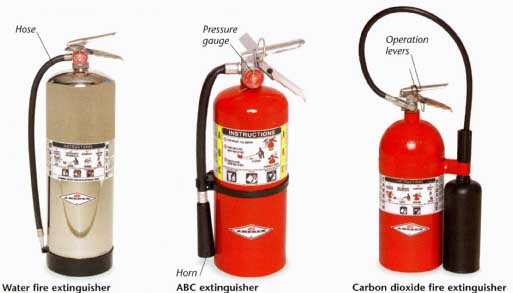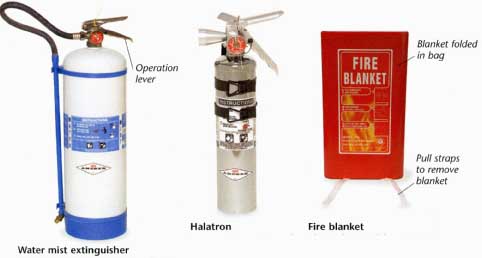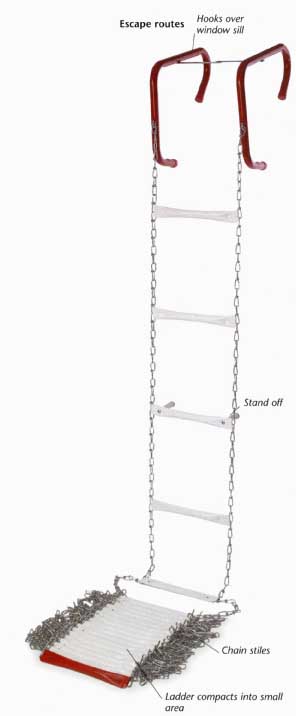As a rule, you should never try to tackle a major fire on your own. However, it's important to know how to deal with minor fires, and for this a fire blanket and a fire extinguisher are essential. Another possibility is to have a sprinkler system installed. If in any doubt as to what equipment to buy, contact your local fire department for advice.

Water fire extinguisher: Water extinguishers
are designed for use on paper, wood, and textile fires. Notice the
hose.
ABC extinguisher: Multipurpose extinguisher
that works on A, B, and C fire classes. Can leave behind a yellow powder.
Notice the pressure gauge and horn.
Carbon dioxide fire extinguisher: This takes away the oxygen
needed for combustion. Not to be used in confined spaces. Notice the
operation levers.

Water mist extinguisher: Uses tap water as an extinguishing
agent. It is able to extinguish multiple types of fire.
Halatron: Ideal for computer and high electrical areas. Also
for areas where easy and thorough cleanup is needed.
Fire blanket: This is designed for covering deep-fryer fires,
or wrapping someone up if they are on fire. A fire blanket is best
located in the kitchen. Notice blanket folded in bag and the pull strops
to remove blanket.

Escape routes and escape ladders: It is essential
to have planned escapes routes for use in the event of a fire. For upper
floors this may mean having an escape ladder or two; these can
be bought in various lengths. Notice: Hooks over window sill; Stand off;
Chain stiles; Ladder compacts into small area.
Fire Doors and Windows
The type of doors and windows you have can make the difference between life and death during a fire. Both can be adapted to maximize your safety.
Fire doors:
These are very effective for hindering a fire and providing extra time for escape. They are more commonly found in commercial buildings, but they can be a regulation in domestic homes, especially in multistory dwellings and properties with attached garages. They are hung using the same techniques as for normal doors, but in addition they need to be equipped with some form of door-closer.
As well as the door having a fire rating, the hinges are also fire-rated. Intumescent strips can be used around the door perimeter. These swell up under the effects of heat, sealing around the edge of the door. Intumescent paint is also available; on heating, this produces a char layer that insulates the door from fire.
Windows:
Most windows afford vital escape routes during a fire, so it's important to ensure that they open and close properly and that any security keys are readily available. Modern vinyl windows have friction stay hinges that limit the degree to which the window can be opened. To ensure that the window can be used as an escape route, install egress friction stay hinges; these allow the window to be opened to its full extent.